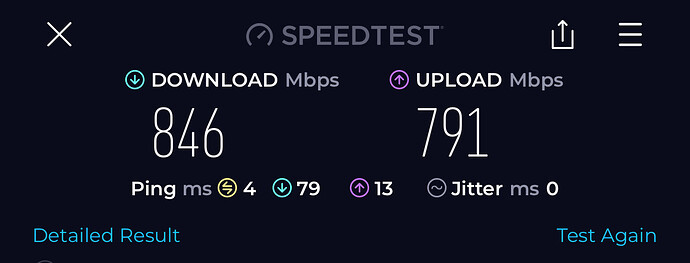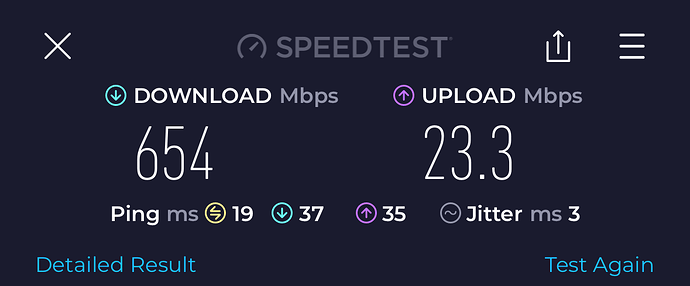Should packet steering be on or off with this device?
Someone correct me if my understanding is off base, but I believe packet steering can be beneficial in setups not utilizing hardware flow offloading (which this device does support). So for users using SQM for example (which is not compatible with flow offloading), then it may be useful... but it's still a question better answered through trial & error with every particular setup.
It's off default, at least in 23.05.3 for the GL-MT6000 but it's on default with my DIR860L running 23.05.3.
There might be a reason why it's set to off default with the GL-MT6000?
I've always enabled packet steering on my devices. WRT32X, R4S, etc. now this. I remember reading a Linux article a while back showing performance gains with it. It was actually Google that submitted it into the kernel iirc. I always wondered if helps all hardware, nevertheless it's enabled on my GL-MT6000.
edit: article here, not sure how it applies currently though.
Been running a couple of weeks now and all running good,
added a usb fan, not that i feel it needed to, it runs so much cooler then the wrt3200, but why not get som airflow over it, looking at the temp guess where i installed the fan
temperature where it´s located is around 15-16c
this is the backup wrt3200 that more or less just idles (also with a fan but around 21-22c)
both fan reduces temp around 10c
maby not the most important post but you get it anyway;)
These temperatures don't indicate that you need a fan.
Adding a fan will just pull in more dust over time.
Is there a "safe´n easy" way going from snapshot to stable 23.05.3?
is this doable in downgrading?
auc -c -b 23.05 -B 23.05.3
or should i just get a sysupgrade file with "my" packages and reconfigure?
Little internet speedtest on wifi 5ghz/80mhz/wed (edit: iphone 15 is a 2x2 client) from my couch on latest main snapshot w/mt76 driver update (wired i'm 950 down). About the same as before, pings are quite stable too.
The clean way would be to backup the configuration and then recreate it once on 23.05.3.
But why don’t you just try auc with keeping the configuration?
What is the worst that can happen?
If I remember correctly, quite some people switched back and forth between the snapshot and the release, once it came out.
If it doesn’t work, you can still reset and recreate it manually.
- Download your backup
- Use the firmware selector to get your sysupgrade with your packages as desired
- Flash your sysupgrade while keeping settings
- If something goes wrong (doubtful), reset with the button and consult with your downloaded backup. Probably you will be just fine though.
I’m getting similar with an iphone 13 pro (2x2 client on 80mHz channel, WED enabled dumb access point, no packet steering). Speed upper 700’s - low 800’s on repeat testing. Performance looks good!
Best speed
Best latency
I've moved from either to the other saving the configuration with no issues. You should have no problem (famous last words...).
Never used auc. I didn't know it existed. I usually build an image through the online Image Builder, scp that to the router to /tmp and flash. auc looks pretty neat and seems to automate that process, so the way I look at it, it should work great.
Now that I think more about it, I believe you are correct. I use software and hardware offloading, and the CPU usage is near zero, so packet steering would have little to no effect.
Has anyone noticed that if you issue a "poweroff" command to these units, they restart instead?
I have two of these, both act this way. I like to issue a poweroff command before power cycling.
These units do now have a physical power off switch. Presumably, that means they also have no electronic switch which tells them that they are in an off state and should not boot even if power is supplied. So how would they distinguish between the situation where power was cycled (and they should boot) and the situation where they were turned off without power being disconnected (and they should stay off)?
Exactly. That was my understanding too. Where there’s no HFO, often a single core can get overloaded… so packet steering can help. I’ve also had targets where packet steering increases latency and introduced instability, so that’s why I say that at the end of the day - testing is truly the only way to ensure it’s helping vs hurting.
- My two units DO NOT have power switches. I can't find any picture online that shows a power switch.
- My WRT1900ACS and WAC104 DO have power switches, and they power off with the "poweroff" command.
Even with a power switch, it is best practice to "poweroff" before turning units off.
On reflection, I believe you meant to say "These units do NOT have a physical power off switch."
The point I was trying to make is that you generally can not power off a unit that does NOT have a physical power switch. If an OEM did not design a physical switch, it probably also did not design a way to save a volatile state variable that would tell it that the last command was "power off" (volatile because you want it to be erased if the physical power is cycled). Which means that, as soon as the device is powered off, it will see power and will not know that the power was cycled. In this situation the only reasonable action it can take is boot up.
In my experience, this is how all the routers without a physical power-off switch work.
You halt the CPU. With that in mind, the "halt" command does appear to halt the unit and turn the LED off.





